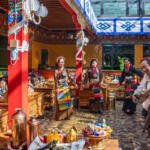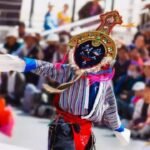Dingri, a region rich in culture and tradition, celebrates various festivals that are deeply rooted in Tibetan spirituality and the rhythm of agricultural life. Two of the most significant festivals are the Tibetan New Year and the Seyang Festival, each with unique practices and beliefs.
The Tibetan New Year: A Ritual of Renewal
The Tibetan New Year, known for its profound spiritual practices, includes the important act of driving away evil spirits. On the 29th day of the 11th month of the Tibetan calendar, as night falls, families gather for a special dinner made from nine different foods, known as “Gutu”. This meal marks the beginning of the ritual to expel ghosts, believed to reside in sweat, dust on clothes, waste materials, and various corners of the home.
The head of the household prepares balls of Tsampa (roasted barley flour dough) and rubs them on each family member’s body and clothes. This act symbolizes the transfer of diseases, bad luck, and evil spirits from the person to the dough. Afterwards, these Tsampa balls, along with the leftovers of “Gutu”, are put into a broken pot to “feed the ghosts”.
The ceremony concludes with the male head of the household lighting a torch and scorching every corner of the house to drive the spirits away with fire. He then runs outside, followed by the female head carrying the pot of “ghost food”, with the rest of the family trailing behind, shouting, “Ghosts, come out!” They discard the torch and pot at a crossroads and joyfully return home. In rural areas, the family also brings back a large round white stone, replacing the previous year’s stone in their home to signify the arrival of the gods.
The Seyang Festival: A Celebration of Prosperity
The Seyang Festival, also known as the Harvest Viewing Festival, is an expression of traditional soul worship. “Seyang” (g.yang) represents blessings, auspiciousness, wealth, happiness, and prosperity. It’s believed that all things, including crops like barley and wheat, possess souls, which are crucial for a bountiful harvest.
As barley ripens and turns yellow, its soul becomes particularly active and may wander off. To prevent this and ensure a successful harvest, farmers conduct rituals to call back the soul of the barley, keeping it within the fields until harvest time. The first cut of barley is offered to the mountain gods in a ceremony known as “Sacrifice to the Mountain”.
Before spring plowing and after the autumn harvest, rituals are performed at a “White God Stone” in the fields to honor the deity of the stone. Every household places a large round white stone, brought back during the Tibetan New Year, in the middle of their fields. This stone, referred to as a sacred or god stone, called “Lado” by the people of Dingri, serves as the guardian spirit of the barley’s soul and is considered an incarnation of the Dragon Maiden.
These festivals, deeply intertwined with the agricultural calendar and spiritual beliefs of Dingri, not only mark the passage of seasons but also reinforce the community’s connection to their environment and traditions.
















